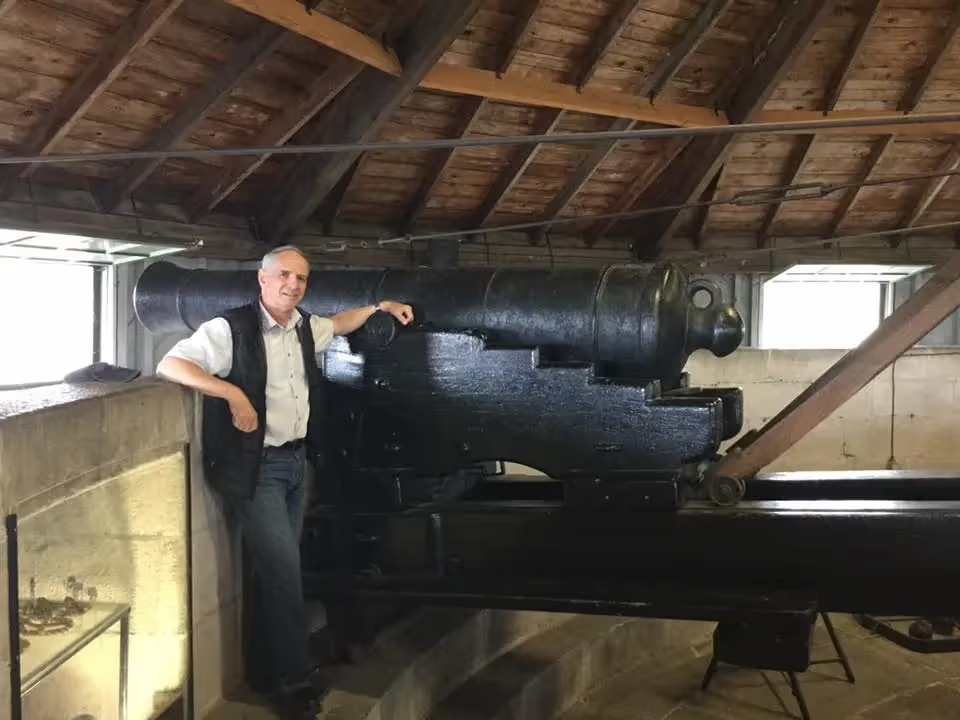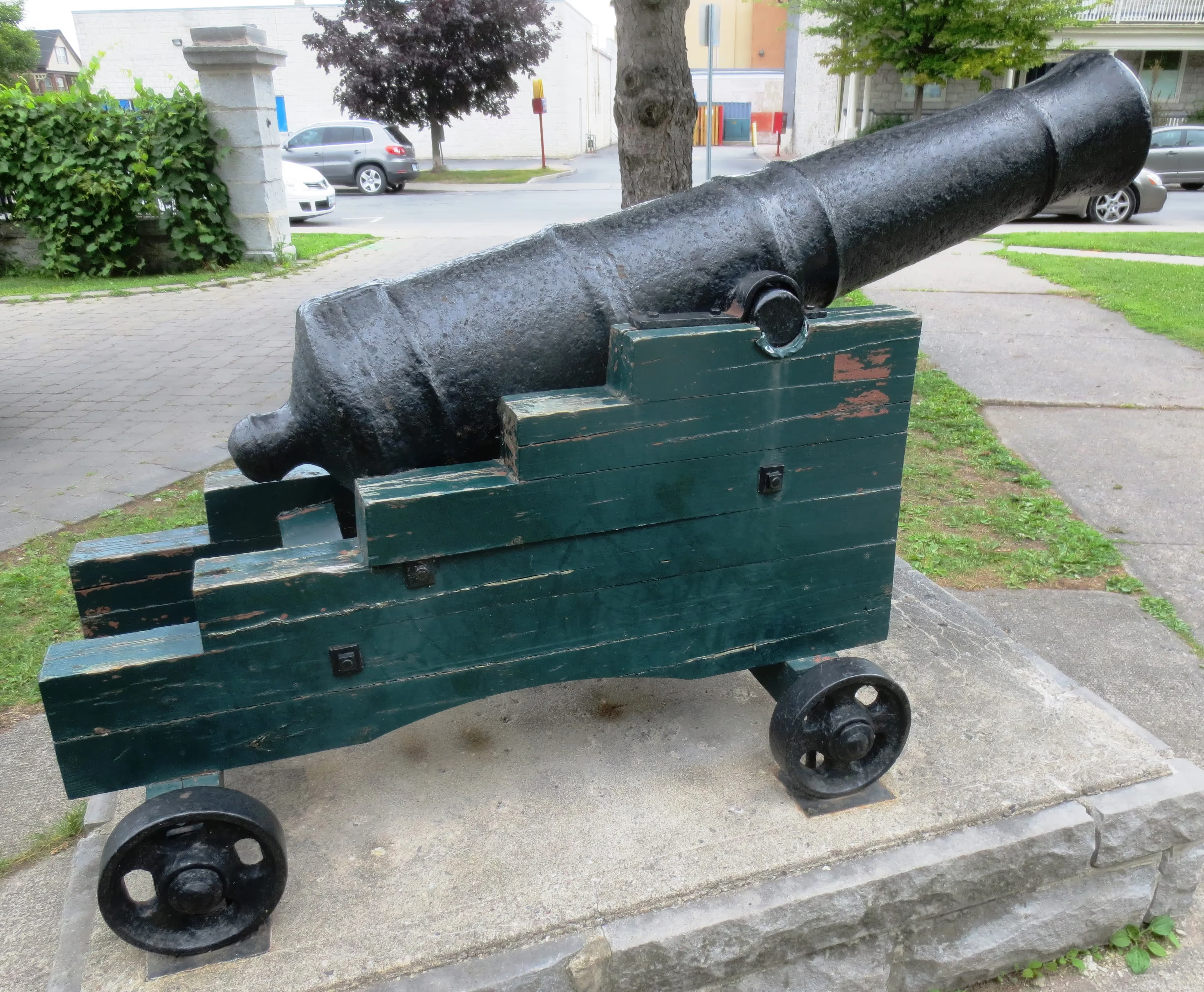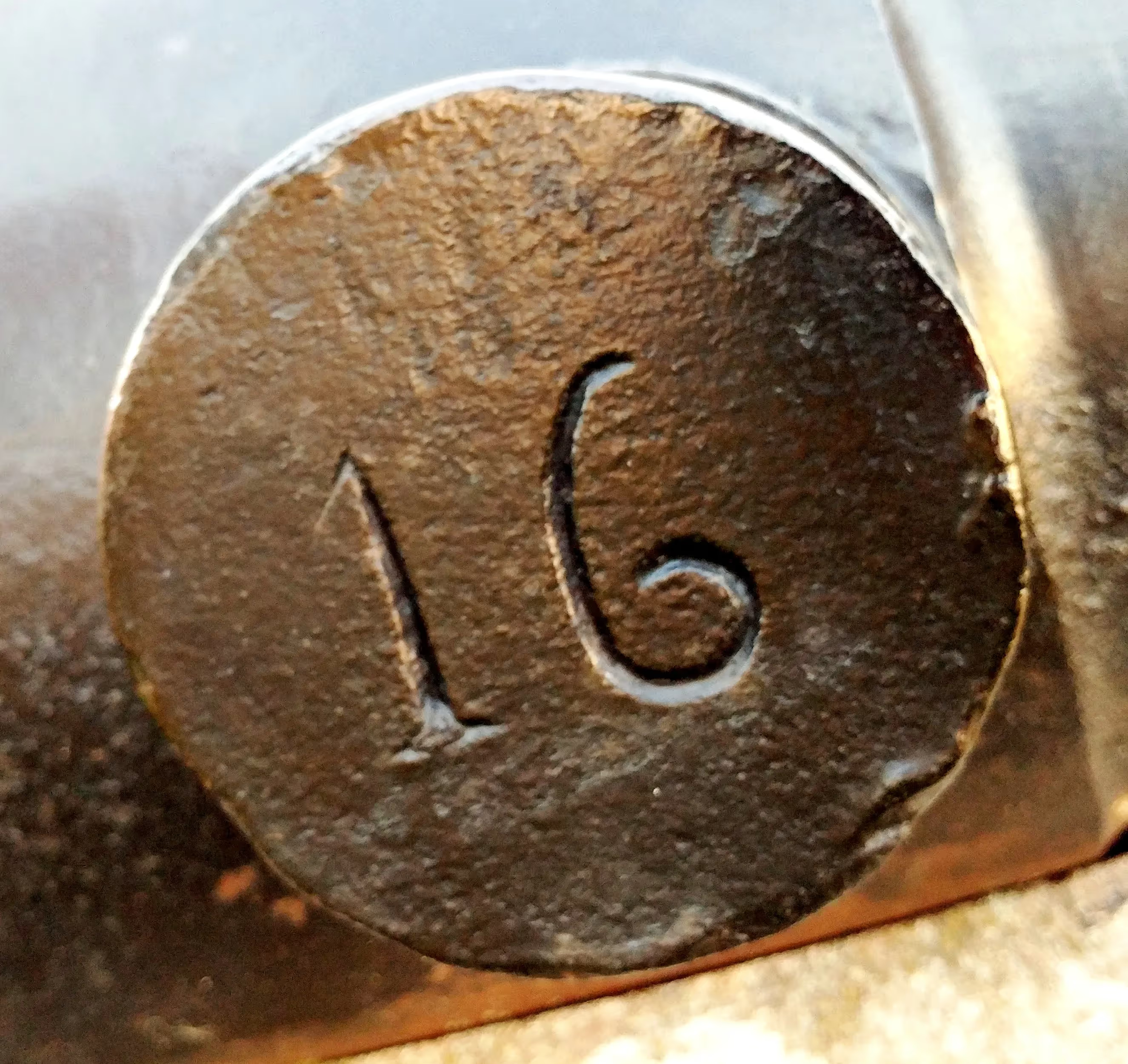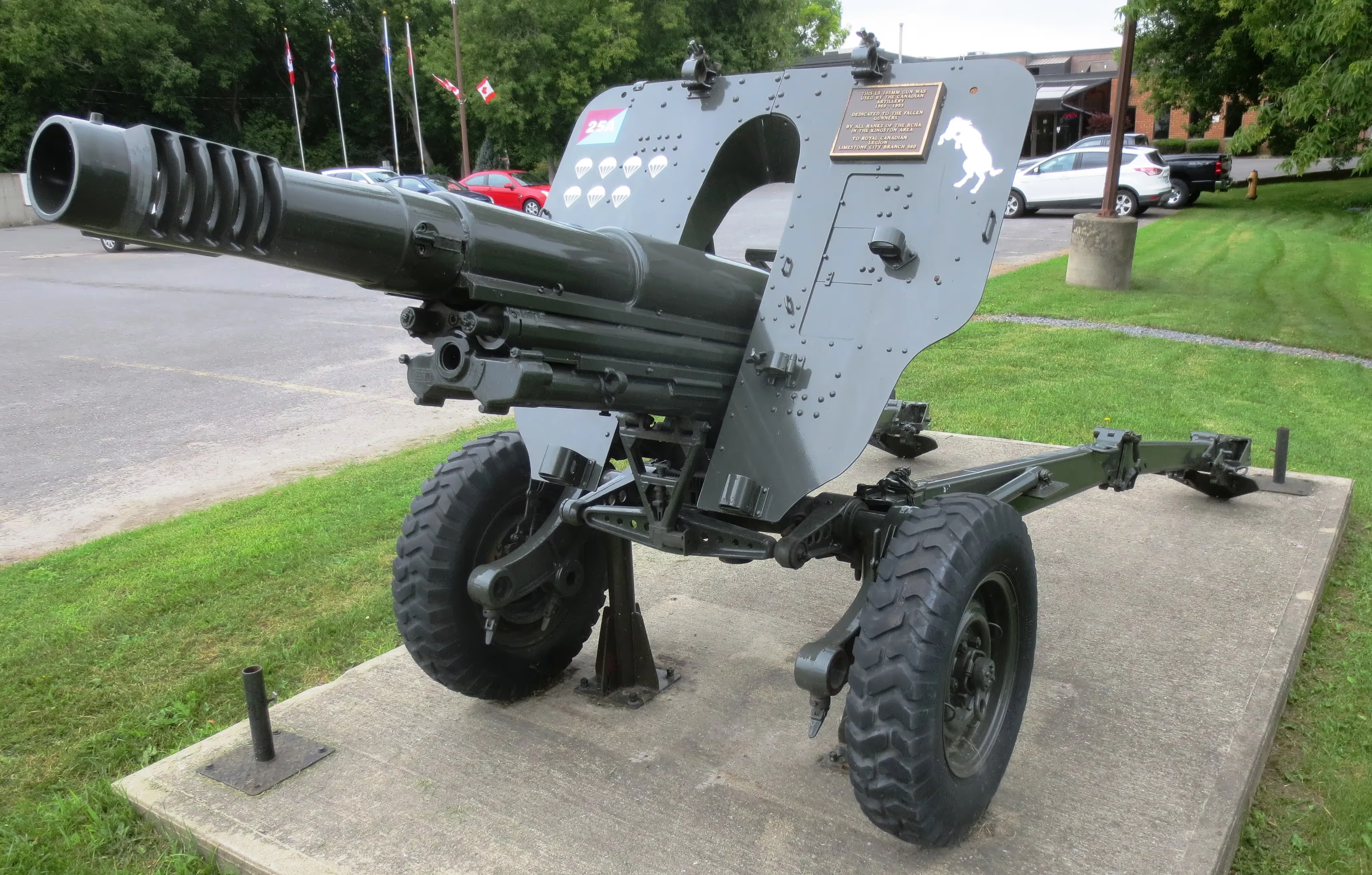Artillery in Canada (5) Ontario: Kingston Parks, HMCS Cataraqui, and Howe Island
City of Kingston and HMCS Cataraqui
The aim of this website is to locate, identify and document every historical piece of artillery preserved in Canada. Many contributors have assisted in the hunt for these guns to provide and update the data found on these web pages. Photos are by the author unless otherwise credited. Any errors found here are by the author, and any additions, corrections or amendments to this list of Guns and Artillery in Canada would be most welcome and may be e-mailed to the author at [email protected].
For all official data concerning the Royal Regiment of Canadian Artillery, please click on the link to their website:
Royal Regiment of Canadian Artillery Website
According to the 1974 edition of ACP 125 Cansupp 1A, "Sheldrake" was the appointment title for the artillery representative in a headquarters. "GOLF" was the arms indicator to be used by artillery callsigns on nets other than their own, especially those of the supported arms.
City of Kingston Parks

(Kingston Historical Society Photo)
Author with a Blomefield Cast Iron 32-pounder 56-cwt Smoothbore Muzzleloading Gun, weight 55-2-14 (6,230 lbs), in the Murney Tower, one of many guns found in the City of Kingston, Ontario.

City of Kingston, location diagram of artillery on display.
Kingston, St. Andrew's Presbyterian Church, 130 Clergy Street East

(Andre Blanchard Photo)



(Author Photos)
Cast Iron 6-pounder Smoothbore Muzzleloading Gun, 3.5 calibre, 3 feet long, no weight stamp, both trunnions corroded, bronze plaque "Shannon’s Cannon", mounted on a wood naval gun carriage. St. Andrew's Presbyterian Church, 130 Clergy Street East. The plaque states "Shannon's Cannon" came from the ramparts of Londonderry, Ireland, where it defended Protestantism from 1649 to 1688. Presented to William Shannon of Kingston in 1865, in 1909 to St. Andrew's Presbyterian Church by Apprentice Boys Derry Lodge # 1. Restored in 1990 by the St. Andrew's Church Veterans Association.
Kingston, McBurney Park, 180 Ordnance Street

(Andre Blanchard Photo)









(Author Photos)
Blomefield Cast Iron 24-pounder 50-cwt Smoothbore Muzzleloading Gun, weight 50-0-14 (5,614 lbs), Samuel Walker & Company of Rotherham, England (WCo) on left trunnion, (Serial No. 102) on the right trunnion, King George III cypher, broad arrow mark, CV, CK on the cascabel, mounted on a concrete stand in McBurney Park, 180 Ordnance Street.
Kingston, Clarence Street Park







(Author Photos)
German First World War 7.7-cm Feldkanone 96 neuer Art (7.7-cm FK 96 n.A.), (Serial Nr. 8368), weight 6-0-0 (672 lbs) mounted on a pedestal. This is a German Krupp gun that was captured by the 21st Battalion on 9 October 1917 at Vimy near the Les Tilleuls Crossroads. Later, it was taken to the Royal Gun Factory in Woolwich, London. There it was mounted on a Pedestal Mark I and sent back out into the field, where it was used by the 22nd Howitzer Battery. A number of merchant ships were armed with these guns, but it may have been used for static defence at a coastal installation, or it may even have been mounted on a train car or back of a lorry. It is located in Clarence Street Park on the grounds adjacent to St. George's Cathedral in downtown Kingston. It is listed as an Ordnance QF 77-mm Gun Mk 1, 1917, No. 34, with King George V RI cypher.


King George V, reigned from 6 May 1910 to 20 Jan 1936, and his cypher. (Wikipedia Photo)
Kingston, Sir John A. MacDonald Memorial, Crimean War Trophy Guns

(Author Photo)
Sir John A. MacDonald Memorial, flanked by a pair of Russian Smoothbore Muzzleloading Guns captured during the Crimean War and presented to Canada by Queen Victoria. The British seized some 1,500 iron SBML guns and hundreds of bronze cannon at the end of the Crimean War (1853-1856). Shortly afterwards, guns captured at the great Russian Naval base of Sevastopol in the Crimea were offered for display in towns and cities throughout the UK and the British Empire. The City of Kingston received two of these guns.







Russian Cast Iron 36-pounder Smoothbore Muzzleloading Gun, (Serial No. 90565) on left trunnion, (36 P, 168 1/2 P, 1826, G) on right trunnion, probably cast by Foullon at Alexandrovski, with double-headed Eagle, 6.75 calibre, 8 feet 4-inches long, mounted on a wood naval gun carriage, Crimean War Trophy, 1854-1855, No. 1 in front of the Sir John A MacDonald statue, King and West Street park.


%2520Kingston%252C%2520Ontario%252C%252028%2520Oct%25202017%2520(3).avif)
%2520Kingston%252C%2520Ontario%252C%252028%2520Oct%25202017%2520(5).avif)

Russian Cast Iron 36-pounder Smoothbore Muzzleloading Gun, (Serial No. 19808) on right trunnion, (36P, 168 1/9, 1823) on left trunnion, probably cast by Foullon at Alexandrovski, with double-headed Eagle, 6.75 calibre, 8 feet 4-inches long, mounted on a naval gun carriage, Crimean War Trophy, 1854-1855, No. 2 in front of the Sir John A MacDonald statue, King and West Street park.
Kingston, Murney Tower Museum


Murney Tower.


Cast Iron 32-pounder 17-cwt Smoothbore Muzzleloading Carronade with a Blomefield pattern breeching ring, weight 16-3-24 (1,900 lbs) above the vent, Murney Tower Museum No. 1 inside the Murney Tower Museum on the main floor. The carronade is a short smoothbore, cast iron cannon, which was used by the Royal Navy and first produced by the Carron Company, an ironworks in Falkirk, Scotland. It was used from the 1770s to the 1850s. Its main function was to serve as a powerful, short-range anti-ship and anti-crew weapon. While considered very successful early on, carronades eventually disappeared as rifled naval artillery changed the shape of the shell and led to fewer and fewer close-range engagements.


Cast Iron 32-pounder 17-cwt Smoothbore Muzzleloading Carronade with a Blomefield pattern breeching ring, weight 17-0-4 (1,908 lbs) above the vent, 1811, No. 2 inside the Murney Tower Museum on the main floor.






Blomefield Cast Iron 32-pounder 56-cwt Smoothbore Muzzleloading Gun, weight 55-2-14 (6,230 lbs), Samuel Walker & Company of Rotherham, England (WCo) on left trunnion, (Serial No. 168) on right trunnion, King George III cypher, broad arrow mark, mounted on a long wood traversing gun carriage. A plaque states this gun was cast in 1800, Murney Tower Museum, top floor. The Blomefield 32-pounder 56-cwt Smoothbore Gun has a length of 9 feet 6 inches. It is the most common 32-pounder in Canada and can be recognized by a reinforcing ring that is slightly raised followed by a definite "step-down" in the barrel just forward of the trunnions heading to the muzzle.
Kingston, McDonald Park
.avif)
.avif)
.avif)
.avif)


.avif)
Cast Iron 24-Pounder 15-cwt Smoothbore Muzzleloading Howitzer, weight 15-0-20 (1,700 lbs), (L) Low Moor Ironworks of Bradford, England, on the left trunnion, (Serial No. 16) on the right trunnion, McDonald Park, King Street West and Emily Street, forward of the Murney Tower Museum.
Cast Iron Lion overlooking the water forward of the Murney Tower and to the rear of the Cast Iron 24-pounder Smoothbore Muzzleloading Howitzer.
Kingston, RCHA Memorial Park
RCHA Memorial, flanked by a pair of 32-pounder 17-cwt SBML Carronades.
.avif)

Cast Iron 32-pounder 17-cwt Smoothbore Muzzleloading Carronade with a Blomefield pattern breeching ring, weight 17-3-0 (1,988 lbs), no other visible markings, mounted on a wood naval gun carriage, No. 1 on the North side of the RCHA Memorial, Park at King and Barrie Streets.
.avif)


Cast Iron 32-pounder 17-cwt Smoothbore Muzzleloading Carronade with a Blomefield pattern breeching ring, weight 17-3-0 (1,988 lbs), no other visible markings mounted on a wood naval gun carriage, No. 2 on the South side of the RCHA memorial, Park at King and Barrie Streets.
.avif)
.avif)
.avif)



(Author Photos)
RCA Memorial plaques.
.avif)
.avif)
.avif)

.avif)
25-Pounder QF Mk. I Field Gun, Serial No. 1230345, Manufacturers Mark: G. & J. W. 1943, Saddle, 25 Pr No. 3 Mk. I. This gun stands in front of the RCHA memorial, Park at King and Barrie Streets.
...and the Princess Patricia's Canadian Light Infantry are also commemorated in this park.
Kingston, Royal Canadian Legion, Branch No. 60, 734 Montreal Street




105-mm L5 Pack Howitzer, marked 05 L10 A1, OTO 1970, MLA 57736, Kg. 358. Data on the side past the breech: No. F CA2661 CDN, N.U.C. 1015-15-020-3503. On face of the Shield: 7 Parachutes, 25A, A horse and a plaque. Royal Canadian Legion, Limestone City Branch No. 560, 734 Montreal Street.
Kingston, Prince of Wales Own Regiment Armoury


(Terry Honour Photos)
106-mm M40A2 Recoilless Anti-Tank Gun, (Serial No. 14910), mounted on a small stand. PWOR Armoury, Montreal Street.


(Author Photos)
M113 with 106-mm Recoilless Rifle mounted, CFB Petawawa, Ontario, May 1974.

M113 with 106-mm Recoilless Rifle, Ex Reforger 74, 3 Mech Cdo, Oct 1974. (Library and Archives Canada Photo, MIKAN No. 4631327)
Fort Henry

(Art Anderson Photo)
The guns on display at Fort Henry, Kingston are listed on a separate web page.

Fort Henry, 1919. (Library and Archives Canada Photo, MIKAN No. 3259967)

Fort Henry plaque.

Artillery Battery, Kingston, Ontario. (Library and Archives Canada Photo, MIKAN No. 3398056)

Royal Garrison Artillery, Fort Henry, ca. 1867. (Library and Archives Canada Photo, MIKAN No. 3192422)
Canadian Forces Base Kingston. The guns on display at CFB Kingston are listed on a separate page on this website.
Fort Frontenac. The guns preserved at Fort Frontenac are listed on a separate page on this website.
Royal Military College, Kingston. The guns preserved on the grounds of RMC are listed on a separate page on this website.
Fort Frederick, Royal Military College, Kingston. The guns preserved in Fort Frederick on the grounds of RMC are listed on a separate page on this website.
Howe Island, Kingston
Cast Iron 3-pounder Smoothbore Muzzleloading Gun mounted on a wheeled carriage with a wooden tampion plug in the barrel, King George III cypher, Private Owner.
HMCS Cataraqui, Naval Reserve, Kingston



(Peggy Brogaard Photos)




(Terry Honour Photos)
Cast Iron 12-pounder Smoothbore Muzzleloading Gun, Queen Anne cypher (18th Century), carriage and shot rack, salvaged from HMS Princess Charlotte, 1812, on display inside the drill hall.
Howe Island, Kingston
Cast Iron 3-pounder Smoothbore Muzzleloading Gun mounted on a wheeled carriage with a wooden tampion plug in the barrel, King George III cypher, Private Owner.





